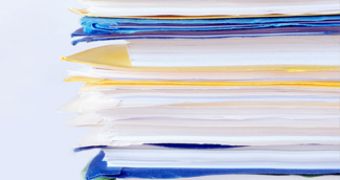Chinese were the first people to make paper 2,200 years ago. They were inspired by wasps, noticing how they chewed wood to produce a material resembling paper for making their nests.
Wood cellulose is the main raw material for making paper, but it can be replaced by other plant fibers. Wood cellulose can come from hardwood or softwood: spruce, fir, eucalyptus, poplar or chestnut.
The simplest variant of wood cellulose is the wood filing obtained in cellulose plants. The log is abraded and the filing is mixed with water. The forming paste is used in paper processing as addition, if the raw material is textile. Through this process a low quality paper is achieved, for a low-keyed short use, like newspapers. A high quality paper (like that used for books, copy-books, and colored magazines) is obtained from cellulose paste. Tiny cut chips achieved from logs are boiled under pressure and action of chemical agents for separating the fibers.
Cellulose fibers are washed and filtered to remove the impurities and dirt, and bleached if a white paper is desired. For an easier processing, plates of fibers are made. They are dried, packed in bales and transported to paper mills. Here, they are broken down by the cellulose paste making machine and mixed with water. A certain amount of paper ends are added to the paste, but first the ends must be cut in pieces, decomposed to the fibers and cleaned for removing the ink.
The paste processing machine modifies the fibers depending on the desired texture and size of the paper. Additive materials are put on the paper to correspond to some standards.
Paper destined for writing has various sticky chemicals added. They do not allow water absorption, impeding the spread of the colorants or water-based inks, so that the writing is readable. Paper destined for printing does not require all these chemicals, as printing dye is water-based.
Paper can be colored through the addition of dyes and paints, like clay dust. Kaolin turns the paper white and opaque.
Most paper today is made through Fourdrinier procedure. The paste passes from the mixer to a machine that transpose it on a mobile band made from a cable or plastic sail. The band, called sieve, can have a width of 9 m (30 ft) and advances with 200-1,000 m (660-3,330 ft) per minute, having also a transversal movement that shakes the paste.
The thickness and weight of the paper depend on the rhythm of paste transposing onto the sieve. While the paste is delivered to the sieve, a certain amount of water drains off through the orifices forming a sheath of wet paper in which the fibers entwine, forming a tissue.
Before leaving the sieve, another amount of water is extracted from this tissue. It can be imprinted a filigree using a patterned roll.
After that, the tissue reaches a felt conveyor belt, passing through a series of heavy rolls, which press it, cramming the material and putting another water amount out of it. The tissue is already strong enough to sustain itself. It passes through a system of metal cylinders heated by vapors, evaporating most of the remaining water. The paper now passes through a system of abraded steel cylinders and smoothing machines that uniform the surface of the paper. The paper is enfolded in giant rolls, which can be cut in smaller rolls, and the smaller ones into paper sheets.
Some types of cartons are made using Fourdrinier machines too, the paste being continuously transformed into thin sheaths. Instead of Fourdrinier machines, sieve cylindrical machines can be used. They differ from the Fourdrinier system as the paste, instead of being disposed on the sieve belt, will be directed towards a metallic sailed sieve cylinder. The difference is that cartons contain more fiber layers than paper.
High quality paper of the magazines is covered by a white colorant, kaolin or gloss, a mix of aluminum oxide and calcium sulfate. The pigment is fixed on the paper using casein, the protein of the milk, or polyvinyl acetate. The gloss covers the irregularities, turning the surface smooth and glossy.
Some types of paper and cartons are treated with wax or paraffin to make them waterproof. In one process, thee paper is passed through molten wax. After sinking, the rolls remove the extra wax from its surface and the paper is turned solid using cold water. This paper can be printed just following a special treatment, as the waxed surface does not absorb the ink.
Another method is to cover just one surface with wax. The paper is passed through a heated cylinder, and the heat melts the wax which will penetrate into the paper fibers. This way, impregnated paper can be used for printing.
Paper can also be made from straws like esparto grass (Macrochloa tenacissimathe). Paper used for banknotes is made of cotton or cotton and flax fibers. The waste stems left behind after extracting the sugar from sugarcane are also used for making paper.
As trees cut for making paper grow back (when seedlings are planted) in 50 years, recycling paper has an increasing role in making it. In the cleaning basins, soap and air are used to remove dye and paints from the recycled paper. The foam from the surface, containing the colorants, is easily removed. Because the paper obtained through recycling is more expensive, only 25 % of the paper wastes worldwide are recycled.
In some countries, paper wastes, mixed with other types of wastes, are used for obtaining methane through fermentation. The resulting gas is caught and used as fuel.
Printing paper is measured worldwide in grams per square meters. Usually, magazine paper has values of 100 to 125.

 14 DAY TRIAL //
14 DAY TRIAL //